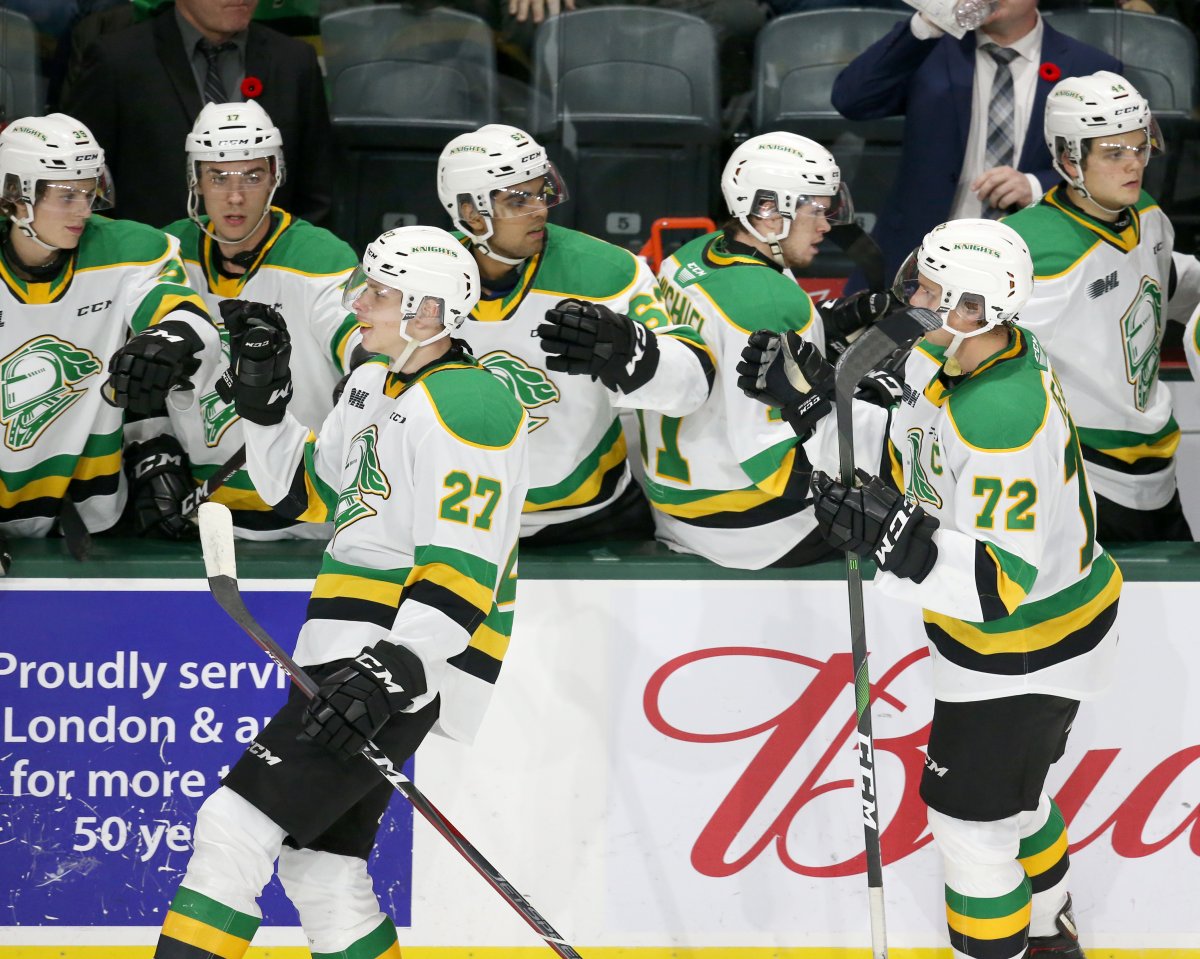Dylan Hunter had tremendous success on the power play when he played for the London Knights. Now, as the team’s assistant coach, he’s helped to create one of the Ontario Hockey League’s top power plays.

It’s not uncommon to see teams stack power plays with their top offensive talent, even if that means having four — and, in some cases, five — forwards on the ice at a time, sacrificing a little defence for a whole lot of offence.
In the past, some Knights teams have gone with that five-forward power-play unit, including when Hunter was playing with the Knights in the early 2000s and played alongside the likes of Corey Perry, Rob Schremp and David Bolland, among other future NHLers.
But Hunter has set up a different look now that he’s behind the bench, and with 49 goals in 188 opportunities, that look is paying off.
This year, the Knights’ first power-play unit is a little unconventional, consisting of three defencemen. London has scored the second most power-play goals in the OHL and are successful on 26.5 per cent of their chances.
Despite the success, Hunter says it’s something the team continually works on in order to keep opponents guessing.
“We look at it every week; we watch video from the weekend and make adjustments throughout the week at practice,” said Hunter, who scored 106 goals during his time as a Knight, 51 of which came on the power play.
“Gotta keep it fresh. There is so much video out that other teams will see what you do and pick up on it. If you keep it the same, it goes stale.”
Power-play time is highly coveted. Most players want to be out on the power play, but the reality is that not everyone gets that opportunity. With eight NHL draft picks on the roster, Hunter has plenty of top talent from which to choose.
He says there’s more to it than just putting the five most skilled guys you have on the ice.
“I like to see sticks that match up. It’s not so much the best five players on the team, it’s which guys had the right stick to be in that situation,” Hunter explained, adding that that’s what led to the decision to add Alec Regula to the five-man unit last season.
Despite being a defenceman, Regula was slotted into a position up front, often referred to as a “bumper.” This spot is typically reserved for a skilled forward with a quick shot and solid control with the puck.

Get daily National news
“Not many people put a defenceman in the slot area, but we already had Adam Boqvist and Evan Bouchard on the flanks, and we needed a guy to be that bumper guy in the middle and Regula was the only right-hand shot we had, so we went with it and he’s done well so far with it,” Hunter said.
Regula, a prospect of the Chicago Blackhawks, admits he was caught off guard when the team made him aware of their power-play aspirations.
“It’s kind of funny for me to be a forward on the power play,” he said. “It’s not something I had done a lot of before and I don’t think it’s something that I will take with me to the next level, but I’m enjoying it now and we’ve been having success so it’s been a lot of fun.”
He’s made the most of the opportunity, scoring 13 goals on the power play this season — the second most in the OHL. Knights forward Connor McMichael has also potted a baker’s dozen with the man advantage.
Regula says having multiple weapons certainly helps make the power play more effective.
“You can take any guy on our power play and any one of us can play any of the positions, so if any of us gets swapped out then we are comfortable with where we need to go and what we need to do,” Regula said of the team’s offensive depth.
“You gotta be moving around all the time in that bumper spot, and I think I’ve kind of gotten into a grove there.”
Hunter agrees, saying it helps having Regula in the middle of the ice. While he’s shown he can put the puck in the net, his 10 power-play assists suggest he’s more than capable setting up his linemates as well.
“He can hold on to it in the middle of ice and make the right place in traffic when it seems like guys are all around you, and he makes the right play, which is extremely hard to do,” said Hunter, who spent five seasons with the Knights, three of which at a time when London had the OHL’s best power play.
Also referred to as a 1-3-1 power play, the system has grown in popularity over the last few years, especially in junior hockey, to the point where a majority of teams employ the tactic.
“The goal of that bumper position is to draw out the middle penalty killers, force them to make a decision to take one player or another, which should create some passing lanes and other opportunities,” said Hunter.
“The big thing is for them to be an outlet. Penalty killers are so aggressive nowadays, you need to have an extra guy to be that bumper, just to be an outlet for one of the perimeter guys when they get trapped.”
Hunter stresses the importance of structure, saying you can’t just have five skilled players out there making things up on the fly. He says creativity is important but that sometimes being too creative can hurt the five-man unit.
“Sometimes you can get a little too cute. In the end, you have to have a default or a comfortable play. It’s not always as complicated as people think, you just have to be self-aware enough to realize it’s not working and simplify it,” he said.
Both Hunter and Regula pointed to the addition of Ryan Merkley early in the season as helping to make London’s power play as dangerous as it is. The San Jose Sharks prospect leads all OHLers with 28 assists on the power play to go along with his seven power-play tallies.
The London Knights enter their game against Guelph on Tuesday night with 70 points, a single point behind the Kitchener Rangers, who are in Erie. That will set up a big game between the longtime Midwest Division rivals, with the Knights hosting the Rangers on Friday night.














Comments